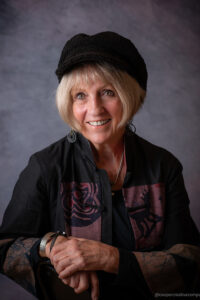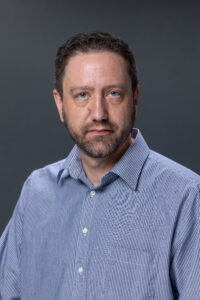Porcelain exhibition at UND delves into ‘DNA’ of ceramic bowls
Artist Elaine Olafson Henry hopes her collection inspires understanding of the depths of the ceramic world

Editor’s note: In the UND LEADS Strategic Plan, the Service core value calls on the University to “promote the arts and humanities, which contribute to the cultural vibrancy of the state and help attract and retain talent in our communities.” The story below, which UND Today first printed on Feb. 22, spotlights one of the University’s latest efforts to promote the arts and humanities, in accordance with the Plan.
****
How is it that 50 porcelain bowls, made from the same clay and dipped in the same glaze, can end up looking so different?
The answer is surprisingly complex, but it essentially boils down to the bowls being fired in wood-burning kilns – fifty different wood burning kilns, that is, including one on the UND campus.

On display inside the Colonel Eugene E. Myers Gallery at the Hughes Fine Arts Center is the exhibit 50 Bowls, 50 States, 50 Woodfires by ceramic artist Elaine Olafson Henry. The exhibit closes on Thursday, Feb. 29, at 6 p.m. Olafson Henry will be at the gallery at 4:30 p.m. on that day to attend a closing reception for the exhibition.
The exhibit was previously on display at American Museum of Ceramic Art (AMOCA).
The genesis of the exhibit goes back to the fall of 2015, when renowned Wyoming-based artist Olafson Henry wanted to see how some of her ceramic creations would appear after having been fired in a wood-burning kiln. She didn’t have to look far for help. As the former editor and publisher of the international ceramics journals Ceramics: Art & Perception and Ceramics TECHNICAL, she is well connected with that world.
She reached out to a friend in Massachusetts who does wood firing, and he agreed to help her out, provided she sent two bowls: one to satisfy Olafson Henry’s curiosity, and one to auction at a charity event. Both came out with different colors, and the idea of a larger project was born: What if she sent a bowl for firing to an artist in each state?
“The geographic locations in the United States just made it an interesting project,” she told UND Today. “I got to thinking, well, maybe I’ll just keep this going, and see how it works.”
She crafted 50 bowls from the same clay, and of roughly the same shape and size. Then, after bisque-firing them (a preliminary firing to keep the clay stable), she coated them all with the same glaze.
It turns out that the weather at the location of the wood-firing, the type of wood, the temperature of the kilns and the location which the bowls are placed in a kiln, all factor into the final coloration of the bowls.
And despite having the same “DNA,” the finished pieces of art are strikingly different because of those factors.
“They all make variation,” she said.
When asked what she hopes gallery visitors will take away from viewing her exhibit, Olafson Henry, with a smile, turned the question back to UND Today: “Well, number one, look what you have just acquired just about wood firing!” she said. “It’s awareness of the ceramics community, the variation.”
She hopes people also gain insight into what it takes to be a potter. It is much more than using “right brain” (creative) skills, she said. Potters need the “left brain” (logical, scientific) skills when they consider the temperature of the kiln, the length of time they are fired, the object’s position in the kiln and wood types used (not to mention the water that sustained the trees) for firing.
Which brings us to North Dakota and UND.
Olafson Henry reached out to Wesley Smith, UND professor of ceramics and foundations, to fire the North Dakota Bowl. The two had met previously at an event in Wyoming and have since kept in touch, and UND also has a wood-firing kiln.
Smith, it turns out, exemplifies someone who exercises both those left- and right-brain skills. Two weeks ago, UND Today encountered him in the ceramics classroom area in the Hughes Fine Arts building, where he was instructing a graduate student and a pair of resident artists on repairing the bricks inside of a kiln.
“I show my people how to do it because when they get out of here, I want them to be self-sufficient potters,” Smith said.
That means not only working on kilns (and sometimes assembling them from scratch), but also repairing motors on equipment used for clay work and dealing with gas lines for certain kilns, as well as other skills one would mostly associate with a mechanical engineer.
“We do everything ourselves,” he said.
Smith agreed to take on the job of firing the North Dakota bowl in UND’s outdoor wood kiln, but he took the idea a step further. He asked if the collection could be held on display at UND. He was delighted with the answer.
“Things that go to AMOCA don’t generally come up here,” he said.
Assisting in bringing the collection for display at UND is the Myers Foundation, created years ago by Col. Eugene E. Myers, a UND alumnus. He left a large endowment to be distributed equally between UND, Columbia University, Northwestern University and West Virginia University in support of artistic endeavors.
“It’s a very big deal,” Smith said. “(The Foundation) affords us opportunities to bring visiting artists, acquisition of artwork, certain types of publications, computers and books for the library specifically for the arts.”
Smith said unboxing and setting up the exhibit was mind boggling, as he was expecting objects that potters refer to as ‘round and brown.’ He was astounded by what he saw.
“We started unboxing them and setting them up and it’s like, ‘Wow, look at the green,’ and ‘Oh, look at the blue,’” he said. “There was more variation than even we expected.”
Much like Olafson Henry, Smith said he hopes visitors gain an appreciation for all the different factors that created the 50 Bowls exhibit, as well as what goes into being a ceramic artist.
“There’s a huge depth and variety in ceramics,” he said. “In part it’s an art, and it’s also part science. It’s just the fact that every bowl is made from the same clay body, made by the same person, bisqued to the same temperature, glazed with the same glaze — and then every single one of them is different.”
People wishing to learn more about Elaine Olafson Henry and view her work can visit her website. People interested in seeing learning more about Wesley Smith can visit the Raven Wolf Gallery’s website.
****
>> QUESTIONS OR COMMENTS about the UND LEADS Strategic Plan? Your thoughts are welcome! Please contact Angie Carpenter, UND’s director of Special Student Populations, and/or Ryan Zerr, associate vice president for Strategy & Implementation, the co-chairs of the UND LEADS Implementation Committee.
You also may offer your thoughts by visiting the UND LEADS Strategic Plan home page and clicking on the “Provide your feedback” link that you’ll find there.
Thank you for your support of the UND LEADS Strategic Plan!




